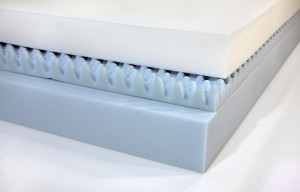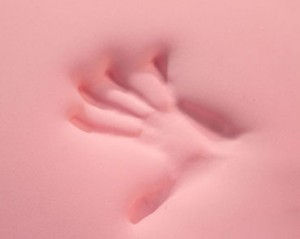Open-cell polyurethane foam, visco-elastic memory foam in particular, has received well-deserved praise for its uses in the comfort and support industry. Bedding is one of the best uses for these materials, as people switch every day from traditional mattress materials to the custom comfort and support that foam pillows, mattresses, and mattress toppers provide.

Comfort for the individual is where most attention is directed with bedding products, and it should be. Recognizing the benefits foam and memory foam can offer in terms of comfort and ability to provide a restful night’s sleep is what should fuel your decision for selecting the right sleeping surface. But in addition to these basic needs, there are many other benefits that foam provides to an individual besides the necessities required for sleep. One of these material traits is the near-elimination of motion transfer through the material, a quality present in every foam mattress and foam mattress topper sold by Foam Factory, Inc.
As previously mentioned, the reason you should purchase a mattress is because it provides your body with the comfort and support it needs to achieve deep, restful sleep. When you sleep alone, this is really all you need to focus on, making your search for the right product easier. But if you share a bed with a partner, have children, or even have pets hopping in and out of bed with you, the transfer of movement energy is something that can greatly impact your sleep.
For some light sleepers, a partner who moves even a little during the night can affect the other. In water beds and some innerspring mattresses, particularly older ones, this movement energy is sent like a shockwave through the mattress’ structure and is transferred to the area of the bed that is supporting you, even while staying still. This is because rigid materials like a spring can only absorb so much energy because of their size, shape and makeup. If the energy generated by movement surpasses the spring’s absorption potential (it usually does), it is transferred through the rest of the mattress and into the other person in the bed until it dissipates. In older mattresses, even the slightest movement can make a mattress feel like a raft floating in the ocean.
Foam bedding on the other hand, is excellent at absorbing motion through its structure, as you have likely seen in TV commercials depicting people jumping or dropping bowling balls on mattresses holding a glass of liquid. A foam topper or mattress features billions of cells in its structure, and each one individually absorbs motion. A single foam cell, when exposed to pressure, will bend, stretch and flex to handle that pressure as best it can, and when its compression point is finally reached, the next cell will bear as much of the load as it can and so on. With cells upon cells in the structure of a foam, each one functions as its own individual shock absorber. The density and size of these cells mean that even if motion is passed through thousands of these cells at once, that energy remains near the user generating it.
To get an idea of the amount of absorption these tiny cells provide in a sleeping surface, imagine the structure of an innerspring mattress applied to a surface area the size of Pennsylvania. If somebody jumped on the coils in Pittsburgh on the west side of the state, a person on the springs in Philadelphia on the east side isn’t going to feel it, given the number of energy absorbing materials between the two. That’s how the billions of foam cells in a foam mattress work, on a more realistic scale. With the struts that make up the structure of each cell of foam flexing and absorbing to their full capability every time they are impacted, the foam retains its softness while quickly dissipating the generated energy. The smaller and closer the cells in a foam material, the better its energy absorption ability, by providing more performance in the same amount of space as a mattress that has a foam material with larger cells, like filter foam or outdoor Dryfast foam.

The reasons having a motion-reducing mattress may be important to an individual are innumerable. You might have a partner who gets up for work much earlier than you do, or maybe you go to bed before they do and don’t want to be woken up. Perhaps you toss and turn during the night and your partner doesn’t want to wake up every time you re-situate yourself. You may have younger children who crawl in and out of your bed frequently. Even on an individual level, if you have an older mattress, you don’t want to feel it continue to move after you’ve gotten comfortable.
A motion-reducing foam bed provides a sense of stability, a very important comfort factor. The energy-absorbing cells provide your body with consistent support that doesn’t diminish during the night. This effect is further increased in memory foam mattresses and memory foam toppers, as the formulation of this material features additional elasticity to form to your body and your movements.
If movement transfer is an issue you’re concerned about in your next bed, consider the performance that foam and memory foam provide as one of the best materials for eliminating the transfer of movement energy. Foam Factory’s line of foam comfort products touts these qualities, making them the right choice for your best night’s sleep.

